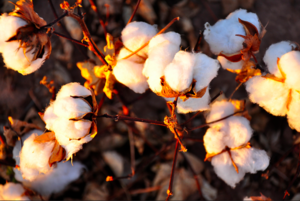
Cotton is the white downy covering of the seed of several special of cotton of cotton plant. It is a native of many parts of the world, being found by Columbus growing in the West Indies and on the main land, by Cortez in Mexico, and Pizarro in Peru.
Quality of cotton[edit | edit source]
Cotton's quality is dependent on its strength and the evenness of the fibre. A standard cotton fibre is about 2.5cm or one inch in length.
Short fibres are the most common and useful variety of cotton.
Fine quality cotton is grown in certain parts of the world. For example, Egyptian cotton is a fine fibre, growing to about 1/5 to 2 inches in length. Sea island cottons are similar in high quality.
A very fine yarn can be spun from cotton due to the spiral character of the cotton fibres. This twist in the fibres is unique to cotton in terms of vegetable or animal fibres (not including synthetic fibres). This springy character renders cotton more elastic than other fabrics made from a fabric such as linen.
Harvesting cotton[edit | edit source]
Cotton must only be picked when fully ripe. This will be clear from seeing the pods fully burst open, with the fibres expanded. An unripe fibre will appear glassy and since it doesn't have sufficient strength and resists dyeing, it isn't ready for use.
Uses of cotton[edit | edit source]
Cotton is used for fabric, clothing, soft furnishings, cotton wool, insulation, filling, craft, etc.
In terms of fabrics, fine cottons are turned into lawn cotton, lace and muslin. Coarser cotton is made into standard cotton fabrics.
Since cotton naturally has a waxy substance on its surface, this must be cleaned off before it can be dyed. This can be removed by washing.
References[edit | edit source]
- Some of the information derived from http://www.gutenberg.org/files/21534/21534-h/21534-h.htm
External links[edit | edit source]
Project Gutenberg public domain ebooks: